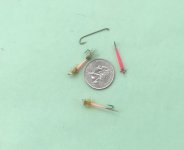Dave_W
Moderator
Staff member
For now anyway....
I cleaned out my small poppers from my bass boxes due to recurrent problems with deep hooked fish. They're being replaced with larger flies. By small, I'm referring to poppers with the typical fingernail sized and shape head combined with a tuft of tail material. These flies were generally about 2" in length counting tail material.
These poppers were great fish catchers for me and I liked 'em based on the fact that so many popper hits were from smaller bass and I believed that smaller poppers had a better hook-up ratio on smaller fish. They were also easier to cast for distance. Bigger SMBs liked 'em too.
Unfortunately, too many larger bass were getting these flies way back in the gullet and this sometimes resulted in bleeding as the downturned hook set into the vascular network around the gill juncture. I wasn't seeing such deep hookings with nymphs or streamers, only with poppers.
The longer pencil style poppers that I often use were also engulfed as well, although the body shape of these poppers seemed to keep them a bit further up in the throat.
Since SMBs regulary hit much larger surface lures and flies, I'm switching out my small poppers for bigger stuff, more in the 3+" size range. Better to miss some of the smaller fish than hook anymore big ones too deep.
Have you noted this? Do SMBs seem to take your poppers in deep? What size poppers do you typically fish for SMBs with?
I cleaned out my small poppers from my bass boxes due to recurrent problems with deep hooked fish. They're being replaced with larger flies. By small, I'm referring to poppers with the typical fingernail sized and shape head combined with a tuft of tail material. These flies were generally about 2" in length counting tail material.
These poppers were great fish catchers for me and I liked 'em based on the fact that so many popper hits were from smaller bass and I believed that smaller poppers had a better hook-up ratio on smaller fish. They were also easier to cast for distance. Bigger SMBs liked 'em too.
Unfortunately, too many larger bass were getting these flies way back in the gullet and this sometimes resulted in bleeding as the downturned hook set into the vascular network around the gill juncture. I wasn't seeing such deep hookings with nymphs or streamers, only with poppers.
The longer pencil style poppers that I often use were also engulfed as well, although the body shape of these poppers seemed to keep them a bit further up in the throat.
Since SMBs regulary hit much larger surface lures and flies, I'm switching out my small poppers for bigger stuff, more in the 3+" size range. Better to miss some of the smaller fish than hook anymore big ones too deep.
Have you noted this? Do SMBs seem to take your poppers in deep? What size poppers do you typically fish for SMBs with?





